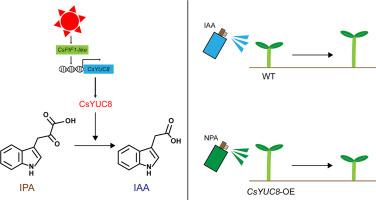Auxin accumulation mediated by the CsPIF1-like-CsYUC8 module drives high temperature-induced hypocotyl elongation in cucumber
IF 6.8
Q1 PLANT SCIENCES
引用次数: 0
Abstract
High temperature trigger various thermomorphogenic adaptations in plants, such as hypocotyl elongation, which disrupts developmental homeostasis and threaten agricultural productivity. However, the molecular mechanism underlying hypocotyl elongation in cucumber under high-temperature conditions remain poorly characterized. Here, we revealed that the increased auxin biosynthesis is a pivotal driver of high-temperature-induced hypocotyl elongation in cucumber. Transcript profiling indicated that CsYUC8, a gene encoding a key auxin biosynthetic enzyme, was upregulated in cucumber hypocotyl elongation under high-temperature conditions. Functional analysis and NPA (auxin inhibitor) treatments demonstrated that CsYUC8-mediated auxin accumulation is essential for thermomorphogenic hypocotyl elongation. Furthermore, we identified a heat-responsive bHLH transcription factor, CsPIF1-like, which directly binds to the CsYUC8 promoter to activate its expression. Those results revealed a CsPIF1-like-CsYUC8 regulatory module that fine-tunes auxin-dependent hypocotyl elongation in cucumber, providing a mechanistic framework for improving heat resilience in cucurbit crops.

CsPIF1-like-CsYUC8模块介导的生长素积累驱动高温诱导的黄瓜下胚轴伸长
高温引发植物的各种热形态适应,如下胚轴伸长,这破坏了植物的发育平衡,威胁到农业生产力。然而,高温条件下黄瓜下胚轴伸长的分子机制尚不清楚。在这里,我们揭示了生长素生物合成的增加是高温诱导黄瓜下胚轴伸长的关键驱动因素。转录谱分析表明,高温条件下,黄瓜下胚轴伸长中编码生长素关键生物合成酶的基因CsYUC8表达上调。功能分析和NPA(生长素抑制剂)处理表明,csyuc8介导的生长素积累对热成型下胚轴伸长至关重要。此外,我们发现了一个热响应的bHLH转录因子,CsPIF1-like,它直接结合到CsYUC8启动子上激活其表达。这些结果揭示了一个CsPIF1-like-CsYUC8调控模块,可以微调黄瓜生长素依赖的下胚轴伸长,为提高黄瓜作物的耐热性提供了一个机制框架。
本文章由计算机程序翻译,如有差异,请以英文原文为准。
求助全文
约1分钟内获得全文
求助全文
来源期刊

Plant Stress
PLANT SCIENCES-
CiteScore
5.20
自引率
8.00%
发文量
76
审稿时长
63 days
期刊介绍:
The journal Plant Stress deals with plant (or other photoautotrophs, such as algae, cyanobacteria and lichens) responses to abiotic and biotic stress factors that can result in limited growth and productivity. Such responses can be analyzed and described at a physiological, biochemical and molecular level. Experimental approaches/technologies aiming to improve growth and productivity with a potential for downstream validation under stress conditions will also be considered. Both fundamental and applied research manuscripts are welcome, provided that clear mechanistic hypotheses are made and descriptive approaches are avoided. In addition, high-quality review articles will also be considered, provided they follow a critical approach and stimulate thought for future research avenues.
Plant Stress welcomes high-quality manuscripts related (but not limited) to interactions between plants and:
Lack of water (drought) and excess (flooding),
Salinity stress,
Elevated temperature and/or low temperature (chilling and freezing),
Hypoxia and/or anoxia,
Mineral nutrient excess and/or deficiency,
Heavy metals and/or metalloids,
Plant priming (chemical, biological, physiological, nanomaterial, biostimulant) approaches for improved stress protection,
Viral, phytoplasma, bacterial and fungal plant-pathogen interactions.
The journal welcomes basic and applied research articles, as well as review articles and short communications. All submitted manuscripts will be subject to a thorough peer-reviewing process.
 求助内容:
求助内容: 应助结果提醒方式:
应助结果提醒方式:


